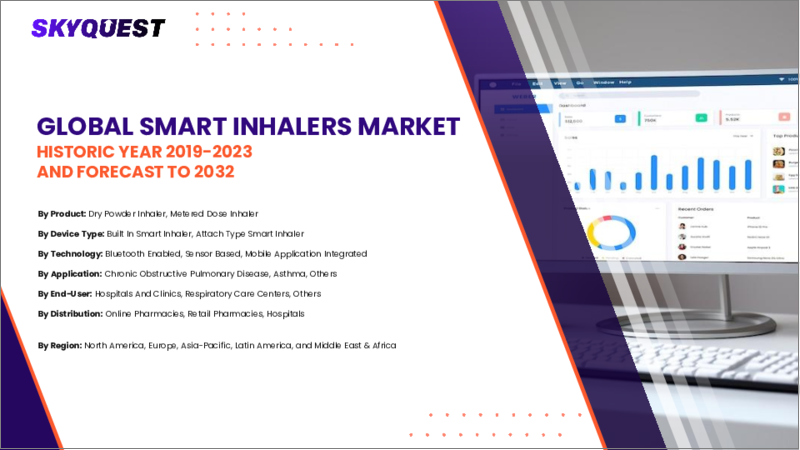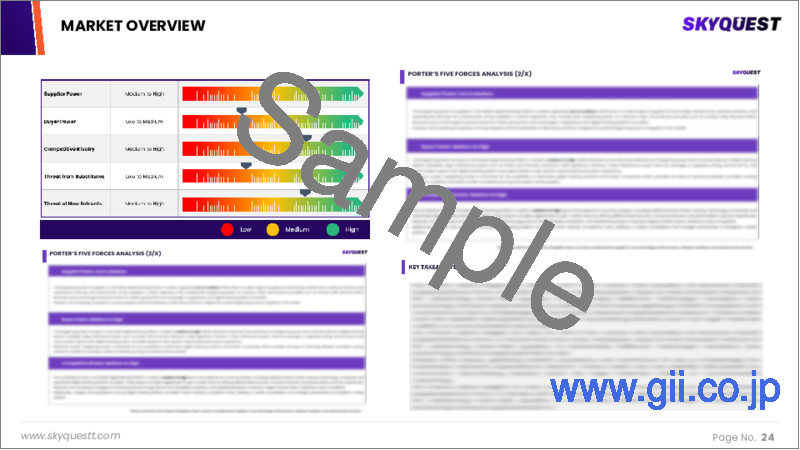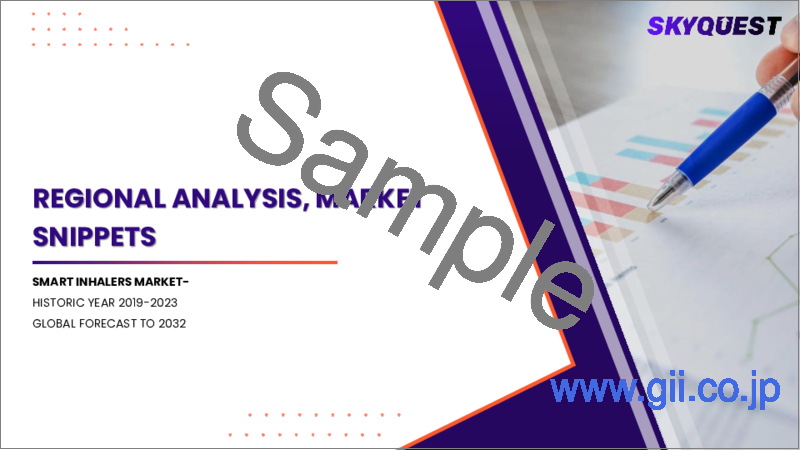|
|
市場調査レポート
商品コード
1663858
スマート吸入器の市場規模、シェア、成長分析:タイプ別、技術別、適応症別、エンドユーザー別、流通別、地域別 - 産業予測 2025~2032年Smart Inhalers Market Size, Share, and Growth Analysis, By Type (Metered Dose Inhalers, Dry Powder Inhalers), By Technology (Bluetooth Enabled, Sensor Based), By Indication, By End User, By Distribution, By Region - Industry Forecast 2025-2032 |
||||||
|
|||||||
| スマート吸入器の市場規模、シェア、成長分析:タイプ別、技術別、適応症別、エンドユーザー別、流通別、地域別 - 産業予測 2025~2032年 |
|
出版日: 2025年02月22日
発行: SkyQuest
ページ情報: 英文 219 Pages
納期: 3~5営業日
|
全表示
- 概要
- 目次
スマート吸入器市場規模は2023年に151億米ドルと評価され、2024年の181億8,000万米ドルから2032年には802億8,000万米ドルに成長し、予測期間(2025-2032年)のCAGRは20.4%で成長する見通しです。
世界のスマート吸入器市場は急速な成長を遂げており、喘息やCOPDなどの呼吸器疾患の管理を一変させています。センサーとBluetoothテクノロジーを搭載したスマート吸入器は、薬剤使用のリアルタイム追跡を可能にし、患者のアドヒアランスを高め、医療従事者が治療計画を効果的に調整できるようにします。主な成長促進要因としては、呼吸器疾患の罹患率の上昇、服薬コンプライアンスの向上に対する需要、モニタリング技術の進歩などが挙げられます。高額な機器コストや限られた認知度といった課題が残る一方で、電子カルテやモバイルヘルスアプリケーションとの統合といった動向は、市場拡大に拍車をかけるものと思われます。結局のところ、スマート吸入器は、病院への受診を最小限に抑え、より個別化されたケアを可能にすることで、コスト削減と患者の転帰改善を実現する大きな機会を提供します。
目次
イントロダクション
- 調査の目的
- 調査範囲
- 定義
調査手法
- 情報調達
- 二次と一次データの方法
- 市場規模予測
- 市場の前提条件と制限
エグゼクティブサマリー
- 世界市場の見通し
- 供給と需要の動向分析
- セグメント別機会分析
市場力学と見通し
- 市場概要
- 市場規模
- 市場力学
- 促進要因と機会
- 抑制要因と課題
- ポーターの分析
主な市場の考察
- 重要成功要因
- 競合の程度
- 主な投資機会
- 市場エコシステム
- 市場の魅力指数(2024年)
- PESTEL分析
- マクロ経済指標
- バリューチェーン分析
- 価格分析
スマート吸入器市場規模:タイプ別& CAGR(2025-2032)
- 市場概要
- 定量吸入器
- ドライパウダー吸入器
- ネブライザー
スマート吸入器市場規模:技術別& CAGR(2025-2032)
- 市場概要
- Bluetooth対応
- センサーベース
- モバイルアプリケーション統合
スマート吸入器市場規模:適応症別& CAGR(2025-2032)
- 市場概要
- 喘息
- 慢性閉塞性肺疾患
- アレルギー性鼻炎
- 嚢胞性線維症
スマート吸入器市場規模:エンドユーザー別& CAGR(2025-2032)
- 市場概要
- 病院
- 在宅ケア
- 製薬会社
スマート吸入器市場規模:流通別& CAGR(2025-2032)
- 市場概要
- オンライン薬局
- 小売薬局
- 病院
スマート吸入器市場規模:地域別& CAGR(2025-2032)
- 北米
- 米国
- カナダ
- 欧州
- ドイツ
- スペイン
- フランス
- 英国
- イタリア
- その他欧州地域
- アジア太平洋地域
- 中国
- インド
- 日本
- 韓国
- その他アジア太平洋地域
- ラテンアメリカ
- ブラジル
- その他ラテンアメリカ地域
- 中東・アフリカ
- GCC諸国
- 南アフリカ
- その他中東・アフリカ
競合情報
- 上位5社の比較
- 主要企業の市場ポジショニング(2024年)
- 主な市場企業が採用した戦略
- 最近の市場動向
- 企業の市場シェア分析(2024年)
- 主要企業の企業プロファイル
- 企業の詳細
- 製品ポートフォリオ分析
- 企業のセグメント別シェア分析
- 収益の前年比比較(2022-2024)
主要企業プロファイル
- Adherium Limited(New Zealand)
- Aptar Group Inc.(Cohero Health Inc.)(USA)
- AstraZeneca, Inc.(UK)
- GlaxoSmithKline Plc.(UK)
- Novartis AG(Switzerland)
- OPKO Health Inc.(USA)
- Philip Morris International Inc.(Vectura Group Plc)(USA/UK)
- ResMed Inc.(Propeller Health)(USA)
- Teva Pharmaceutical Industries Ltd.(Israel)
- Boehringer Ingelheim International GmbH(Germany)
- 3M Health Care Limited(USA)
- Lupin Limited(India)
- Findair Sp. z o.o.(Poland)
- Inspiro Medical Ltd.(Israel)
- Cognita Labs, LLC.(USA)
- AireHealth Inc.(USA)
- Zeolr Technologies Pvt Ltd.(India)
- H&T Presspart Manufacturing Ltd.(Germany)
結論と提言
Smart Inhalers Market size was valued at USD 15.1 billion in 2023 and is poised to grow from USD 18.18 billion in 2024 to USD 80.28 billion by 2032, growing at a CAGR of 20.4% during the forecast period (2025-2032).
The Global Smart Inhalers Market is experiencing rapid growth, transforming the management of respiratory diseases like asthma and COPD. Equipped with sensors and Bluetooth technology, smart inhalers enable real-time tracking of medication use, enhancing patient adherence and allowing healthcare providers to tailor treatment plans effectively. Key growth drivers include the rising incidence of respiratory conditions, the demand for better medication compliance, and advances in monitoring technologies. While challenges such as high device costs and limited awareness persist, trends like integration with electronic medical records and mobile health applications are poised to fuel market expansion. Ultimately, smart inhalers present significant opportunities for cost savings and improved patient outcomes by minimizing hospital visits and enabling more personalized care.
Top-down and bottom-up approaches were used to estimate and validate the size of the Smart Inhalers market and to estimate the size of various other dependent submarkets. The research methodology used to estimate the market size includes the following details: The key players in the market were identified through secondary research, and their market shares in the respective regions were determined through primary and secondary research. This entire procedure includes the study of the annual and financial reports of the top market players and extensive interviews for key insights from industry leaders such as CEOs, VPs, directors, and marketing executives. All percentage shares split, and breakdowns were determined using secondary sources and verified through Primary sources. All possible parameters that affect the markets covered in this research study have been accounted for, viewed in extensive detail, verified through primary research, and analyzed to get the final quantitative and qualitative data.
Smart Inhalers Market Segments Analysis
Global Smart Inhalers Market is segmented by Type, Technology, Indication, End User, Distribution and region. Based on Type, the market is segmented into Metered Dose Inhalers, Dry Powder Inhalers and Nebulizers. Based on Technology, the market is segmented into Bluetooth Enabled, Sensor Based and Mobile Application Integrated. Based on Indication, the market is segmented into Asthma, Chronic Obstructive Pulmonary Disease, Allergic Rhinitis and Cystic Fibrosis. Based on End User, the market is segmented into Hospital, Homecare and Pharmaceutical Companies. Based on Distribution, the market is segmented into Online Pharmacies, Retail Pharmacies and Hospitals. Based on region, the market is segmented into North America, Europe, Asia Pacific, Latin America and Middle East & Africa.
Driver of the Smart Inhalers Market
The rapid evolution of technology is a major catalyst for growth in the smart inhalers market. Innovations in advanced sensors, connectivity features, and data analytics have transformed how respiratory diseases are managed. Smart inhalers now possess the capability to gather and transmit crucial data regarding medication adherence, inhalation techniques, and environmental factors directly to healthcare providers in real-time. This facilitates personalized treatment approaches and enhances patient outcomes. For instance, Propeller Health has introduced a sensor-based smart inhaler system that attaches to regular inhalers, monitoring medication usage. The data is then relayed to a mobile application, which offers valuable insights and reminders, empowering patients and enabling healthcare providers to deliver tailored support.
Restraints in the Smart Inhalers Market
A significant restraint in the smart inhalers market is the higher price linked to these innovative devices when compared to traditional inhalers. The sophisticated technology and connectivity options integrated into smart inhalers result in elevated costs, which can hinder their adoption, especially in areas with constrained healthcare budgets and affordability issues. Prices for smart inhalers typically range from $100 to $300, influenced by brand and features. This financial barrier is particularly challenging for patients with limited financial means or insufficient insurance coverage, potentially slowing the uptake of smart inhalers in various markets and consequently impeding overall market growth.
Market Trends of the Smart Inhalers Market
The smart inhalers market is experiencing a significant trend with the integration of artificial intelligence (AI) and machine learning (ML) technologies, revolutionizing the management of respiratory diseases. These advanced algorithms analyze extensive datasets from smart inhalers, identifying usage patterns and providing predictive insights that enable healthcare providers to tailor treatment plans effectively. Companies like Cohero Health are at the forefront, utilizing AI and ML to combine inhaler usage data, environmental factors, and patient-specific information, allowing for real-time feedback and customized recommendations. This trend not only enhances patient engagement and compliance but also significantly improves clinical outcomes, positioning smart inhalers as a critical component of modern respiratory care.
Table of Contents
Introduction
- Objectives of the Study
- Scope of the Report
- Definitions
Research Methodology
- Information Procurement
- Secondary & Primary Data Methods
- Market Size Estimation
- Market Assumptions & Limitations
Executive Summary
- Global Market Outlook
- Supply & Demand Trend Analysis
- Segmental Opportunity Analysis
Market Dynamics & Outlook
- Market Overview
- Market Size
- Market Dynamics
- Drivers & Opportunities
- Restraints & Challenges
- Porters Analysis
- Competitive rivalry
- Threat of substitute
- Bargaining power of buyers
- Threat of new entrants
- Bargaining power of suppliers
Key Market Insights
- Key Success Factors
- Degree of Competition
- Top Investment Pockets
- Market Ecosystem
- Market Attractiveness Index, 2024
- PESTEL Analysis
- Macro-Economic Indicators
- Value Chain Analysis
- Pricing Analysis
Global Smart Inhalers Market Size by Type & CAGR (2025-2032)
- Market Overview
- Metered Dose Inhalers
- Dry Powder Inhalers
- Nebulizers
Global Smart Inhalers Market Size by Technology & CAGR (2025-2032)
- Market Overview
- Bluetooth Enabled
- Sensor Based
- Mobile Application Integrated
Global Smart Inhalers Market Size by Indication & CAGR (2025-2032)
- Market Overview
- Asthma
- Chronic Obstructive Pulmonary Disease
- Allergic Rhinitis
- Cystic Fibrosis
Global Smart Inhalers Market Size by End User & CAGR (2025-2032)
- Market Overview
- Hospital
- Homecare
- Pharmaceutical Companies
Global Smart Inhalers Market Size by Distribution & CAGR (2025-2032)
- Market Overview
- Online Pharmacies
- Retail Pharmacies
- Hospitals
Global Smart Inhalers Market Size & CAGR (2025-2032)
- North America (Type, Technology, Indication, End User, Distribution)
- US
- Canada
- Europe (Type, Technology, Indication, End User, Distribution)
- Germany
- Spain
- France
- UK
- Italy
- Rest of Europe
- Asia Pacific (Type, Technology, Indication, End User, Distribution)
- China
- India
- Japan
- South Korea
- Rest of Asia-Pacific
- Latin America (Type, Technology, Indication, End User, Distribution)
- Brazil
- Rest of Latin America
- Middle East & Africa (Type, Technology, Indication, End User, Distribution)
- GCC Countries
- South Africa
- Rest of Middle East & Africa
Competitive Intelligence
- Top 5 Player Comparison
- Market Positioning of Key Players, 2024
- Strategies Adopted by Key Market Players
- Recent Developments in the Market
- Company Market Share Analysis, 2024
- Company Profiles of All Key Players
- Company Details
- Product Portfolio Analysis
- Company's Segmental Share Analysis
- Revenue Y-O-Y Comparison (2022-2024)
Key Company Profiles
- Adherium Limited (New Zealand)
- Company Overview
- Business Segment Overview
- Financial Updates
- Key Developments
- Aptar Group Inc. (Cohero Health Inc.) (USA)
- Company Overview
- Business Segment Overview
- Financial Updates
- Key Developments
- AstraZeneca, Inc. (UK)
- Company Overview
- Business Segment Overview
- Financial Updates
- Key Developments
- GlaxoSmithKline Plc. (UK)
- Company Overview
- Business Segment Overview
- Financial Updates
- Key Developments
- Novartis AG (Switzerland)
- Company Overview
- Business Segment Overview
- Financial Updates
- Key Developments
- OPKO Health Inc. (USA)
- Company Overview
- Business Segment Overview
- Financial Updates
- Key Developments
- Philip Morris International Inc. (Vectura Group Plc) (USA/UK)
- Company Overview
- Business Segment Overview
- Financial Updates
- Key Developments
- ResMed Inc. (Propeller Health) (USA)
- Company Overview
- Business Segment Overview
- Financial Updates
- Key Developments
- Teva Pharmaceutical Industries Ltd. (Israel)
- Company Overview
- Business Segment Overview
- Financial Updates
- Key Developments
- Boehringer Ingelheim International GmbH (Germany)
- Company Overview
- Business Segment Overview
- Financial Updates
- Key Developments
- 3M Health Care Limited (USA)
- Company Overview
- Business Segment Overview
- Financial Updates
- Key Developments
- Lupin Limited (India)
- Company Overview
- Business Segment Overview
- Financial Updates
- Key Developments
- Findair Sp. z o.o. (Poland)
- Company Overview
- Business Segment Overview
- Financial Updates
- Key Developments
- Inspiro Medical Ltd. (Israel)
- Company Overview
- Business Segment Overview
- Financial Updates
- Key Developments
- Cognita Labs, LLC. (USA)
- Company Overview
- Business Segment Overview
- Financial Updates
- Key Developments
- AireHealth Inc. (USA)
- Company Overview
- Business Segment Overview
- Financial Updates
- Key Developments
- Zeolr Technologies Pvt Ltd. (India)
- Company Overview
- Business Segment Overview
- Financial Updates
- Key Developments
- H&T Presspart Manufacturing Ltd. (Germany)
- Company Overview
- Business Segment Overview
- Financial Updates
- Key Developments






